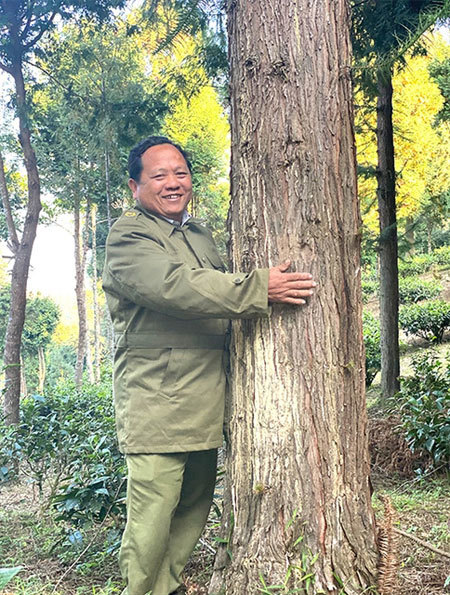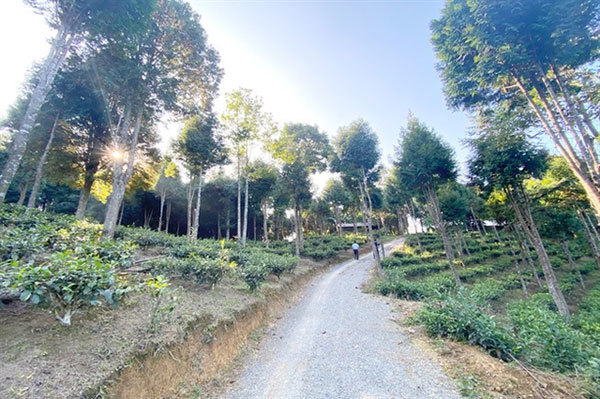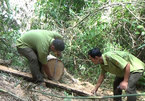 |
| Vu Va Chong a resident from Huoi Tu Commune in central province of Nghe An’s Ky Son District consider each tree as one of his friends. Photo plo.vn |
Vu Va Chong lives in Huoi Tu Commune in Nghe An Province’s Ky Son District and has planted pơ mu (fokienia) and samu (Chinese fir) trees and inspired other local residents to follow his example.
Twenty years have passed and he now has thousands of pơ mu and samu trees.
Chong recalled his life as a young man.
“It was in 1984, I undertook military service at Ky Son District Military Command. My comrades and I were assigned to deal with illegal loggers at pơ mu forest in the border area many times," he said.
Looking at the hundred-year-old pơ mu and samu trees that had been cut down, he could not help but feel sad. He hoped that he could do something to stop them from disappearing.
Pơ mu is known as a precious species and has been in Vietnam’s Red Book list of endangered species since 1996.
It is heavily exploited for its unique smell and beautiful wood grain.
After he completed military service, Chong asked local authorities to allocate him Au Tien – a barren hill - for production.
In the first three years, he only planted tea trees and raised chickens. With the money gained from selling tea and chickens, he bought pơ mu and samu seedlings. But he failed in his first attempt.
“The first batch of trees was a huge failure as half of the 3,000 seedlings died,” he told Pháp luật Thành phố HCM (HCM City Law) newspaper.
However, he did not give up and went to neighbouring Tay Son Commune to learn about planting techniques.
He knew the reason for his failure – the holes he made were too small and the soil was not soft enough.
In addition, he needed to maintain moisture for the plants.
His efforts have paid off as the trees grew up very well.
Now Chong has more than 6,000 pơ mu and samu trees planted on a hill.
Samu is valued for durable wood as well as its resistance to termites, rot, and numerous fungi.
He boasted that many tourists have visited Au Tien Hill to enjoy the forest. Children in the localities often come here for parties.
 |
| Au Tien Hill which once a barren hill has become a tourist attraction thanks to efforts by Vu Va Chong. Photo plo.vn |
Chong said many people had offered him large sums of money for the wood, but he refused them.
“I’ve planted and tended the trees for nearly 20 years. I consider each tree a friend. It is very sad to sell them,” he said.
Danh Ba Long, vice chairman of Huoi Tu Commune’s People’s Committee, said Chong’s model of planting pơ mu trees could be expanded in the commune to help re-plant the forest and improve the incomes of local residents who wanted to use them for sustainable commercial purposes.
According to Long, afforestation in Huoi Tu is not easy because most of the local people are of the Mong ethnic minority and poverty has been lingering for many generations.
The land which is 1,200 metres above the sea level makes it difficult to grow any plant, he said.
Inspired by Chong's success, other locals have started planting trees, Long said.
Many households such as Vu Nhia Hua's and Lay Y No's in Huoi Mu Village and Vu Giong Cho's in Huoi Dun Village have planted from 1,000-2,000 pơ mu and samu trees. They have also cultivated Shan tea in combination with raising chickens and cows which brings good income and helps alleviate poverty.
“Chong doesn’t only supply seedlings for local people at affordable prices and but also gives them instructions on how to plant them properly,” Long said. VNS

We are 'trading nature for economic benefits': senior expert
Prof. Nguyen Ngoc Lung, Director of the Institute of Sustainable Forest Management and Forest Certification, has been working in the forestry industry for nearly 60 years. He is called "the man of the forest".

Minister calls for forest protection and management efforts
Central Highlands localities need to raise the responsibility among forest owners and management to improve protection and development of the areas.